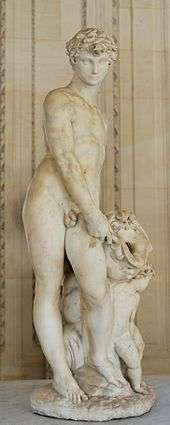Pierino da Vinci

Pierino da Vinci (c. 1529–1553 or 1554), born Pier Francesco di Bartolomeo di Ser Piero da Vinci (Italian: [pjeˈriːno da ˈvintʃi]), was an Italian sculptor, born in the small town of Vinci in Tuscany; he was the nephew of Leonardo da Vinci.
The son of Bartolomeo da Vinci, Leonardo’s younger brother, Pierino demonstrated artistic ability at an early age; and was seen by his family as the heir to his uncle's talent. He studied under both Baccio Bandinelli (1488–1560) and Niccolò Tribolo (1500–1550). Pierino died from malarial fever at the age of 23, in Pisa, in 1553-4.
The biographical information about this artist comes almost exclusively from Lives of the Most Excellent Painters, Sculptors, and Architects by Giorgio Vasari; this history of art and artists reports a mixture of fact and legend, making it difficult to establish reliable historical information about the subject, in the absence of other sources. A relief that was admired by Vasari and was long thought to be by Michelangelo was recently the subject of an unsuccessful effort to keep it in the United Kingdom when it came up for auction. According to Vasari the relief was made by Pierino in 1549 for Luca Martini dell’Ala (c. 1500–1561), who was then in Pisa in the service of Cosimo I de' Medici, Grand Duke of Tuscany. It depicts Ugolino and his sons.[1] The work is now in the collection of the Liechtenstein Museum.[2]
Several sculptures, now believed to be by Pierino da Vinci, were at one time attributed to Michelangelo.
References
- ↑ The relief was brought to England by the painter Henry Trench (c. 1685-1726) before 1719 and only recently were the Martini arms found on the back on website for UK department of culture
- ↑ Relief of Ugolino and his sons on Liechtenstein museum website
Bibliography
- Britta Kusch-Arnhold, Pierino da Vinci, Beiträge zur Kunstgeschichte des Mittelalters und der Renaissance, vol. 14, Münster, Rhema-Verlag, 2008 (ISBN 978-3-930454-74-7).
- Cianchi, Marco, Pierino da Vinci: atti della giornata di studio, Vinci, Biblioteca leonardiana, Firenze, Becocci, 1995.
- Goguel, Catherine Monbeigl, Maestri toscani del Cinquecento: Michelangelo, Sansovino, Bandinelli, Jacone, Montorsoli, Salviati, Vasari, Dosio, Pierino da Vinci, Giambologna, etc., Firenze, Istituto Alinari, 1979.
- Middeldorf, Ulrich, Additions to the Work of Pierino da Vinci, The Burlington Magazine for Connoisseurs, Vol. 53, No. 309 (Dec., 1928), 298-306.
- Rosi, Mino, Pierino da Vinci, Profilo Interpretativo, Pisa, ETS, 2000.
- Vasari, Giorgio, Le Vite delle più eccellenti pittori, scultori, ed architettori, many editions and translations.
External links
![]() Media related to Pierino da Vinci at Wikimedia Commons
Media related to Pierino da Vinci at Wikimedia Commons
- Pierino da Vinci in ArtCyclopedia
- Pierino da Vinci's "The Death of Count Ugolino Della Gherardesca and His Sons" at the Lichtenstein museum in Vienna, Austria
|